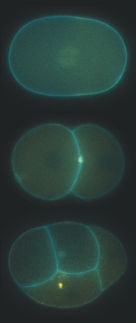New insight into anti-aging mechanisms
Advertisement
Mitochondrial autophagy has been identified as mediator of lifespan extension upon mitochondrial stress in the roundworm Caenorhabditis elegans by the research team of Natascia Ventura, MD, PhD, and leader of the liaison group between the IUF - Leibniz Research Institute for Environmental Medicine and the Central Institute of Clinical Chemistry and Laboratory Medicine of the Heinrich Heine University, Duesseldorf, Germany.
The roundworm C. elegans is widely used in aging research for several reasons: It is a multicellular organism with a short life cycle and mean lifespan of 15-20 days. Its genome is completely sequenced and more than 60 percent of its genes have the same structure and function of human genes. The worm has a small size of about 1 mm, it is transparent, and it has very well characterized phenotypes (appearance) and behaviors. Remarkably, several age-associated features are conserved between C. elegans and humans: progressive degeneration of different tissues, decline in physiological functions and resistance to stress, and increased probability of death with age. These evolutionarily conserved animal features can be analyzed under the microscope to study the effects of genetic or environmental interventions on the aging process, with important implication for human health.
Mitochondria are widely known as powerhouse organelles of the cell. They fulfill several crucial functions thus being of fundamental importance for proper homeostasis of cells and tissues. In the past decade partial depletion of several mitochondrial regulatory proteins from yeast to mammals has been associated with an anti-aging effect. This is surprising, as these proteins are vital and severe depletion can lead to diseases in human. One of these proteins is frataxin. In humans, an inherited severe deficiency of frataxin leads to a rare life-threatening neurodegenerative disorder, the so-called “Friedreich’s ataxia”. Complete deficiency of the analogous protein in C. elegans leads to developmental arrest whereas partial depletion actually prolongs animal lifespan. The underlying mechanisms of this anti-aging effect are largely unknown.
New insights have now been published in the journal “Current Biology” by the team of Natascia Ventura, MD, PhD and leader of the liaison group between the IUF - Leibniz Research Institute for Environmental Medicine and the Central Institute of Clinical Chemistry and Laboratory Medicine of the Heinrich Heine University, Duesseldorf, Germany, in close collaborations with other experts in the field. They could show for the first time that mitophagy, the specific degradation of dysfunctional mitochondria through autophagy (a fundamental cellular recycling process), is causally involved in the lifespan extension upon mitochondrial stress in C. elegans. “The more we know about molecular mechanisms activated by the cells to cope with mitochondrial dysfunction - a common cause of aging and of several devastating disorders - the better they can be exploited for the development of novel therapeutic strategies in the treatment of human mitochondrial-associated (e.g. Friedreich’s ataxia, Parkinson’s disease) and age-related disorders (e.g. Alzheimer’s disease, cancer, cardiovascular disorders). We can thus ultimately provide hope for extension of healthy aging”, states Natascia Ventura. The authors specifically show that upon partial frataxin depletion cells react by activating mitophagy via a mechanism resembling that of iron deprivation. Reducing iron levels may therefore represent a new strategy to possibly deal with mitochondrial dysfunction and ultimately promote healthy aging.
Original publication
Alfonso Schiavi et al.: Iron-Starvation-Induced Mitophagy Mediates Lifespan Extension upon Mitochondrial Stress in C. elegans. Current Biology, published online July 02, 2015




























































